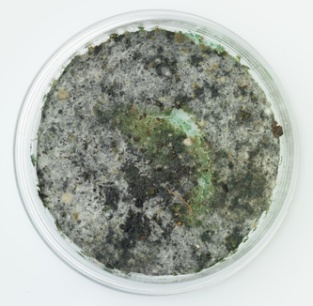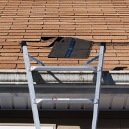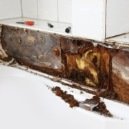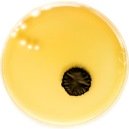Find a pre-screened local mold removal specialist Free Estimate
Find a Mold Specialist Now
Click or Call, Toll-Free 24/7
Trichoderma Mold in the Home
Trichoderma is an extremely widespread form of mold, and is most commonly found in forests, soil, paper, and wood. Trichoderma species adapt to diverse habitats and readily colonize plant roots. You can often find them in soil as well as in association with plants. In general, molds produce an array of toxic chemicals known as mycotoxins. Trichoderma molds produce several different enzymes, a variety of allergens and mycotoxins. Moreover, they can occasionally result in human infection.

You can find this type of mold on a variety of materials, such as decaying wood, textiles, wood items, plant foodstuffs, and stored cereals. Colonies usually start out as white or yellow, and as they mature turn grey or dark green. Trichoderma mold in the home usually develops in spaces with:
- Water-saturated wood
- Gypsum board
- Wallpaper
- Paint
- Air-conditioning filters
- Carpet/mattress dust
Trichoderma mold can enter your home via vents, windows, open doorways, and HVAC systems. It can also be carried in by flood waters. Furthermore, if it is present in the air outside, it can end up clinging itself onto shoes, bags, clothing, and pets. Hence, you could end up carrying it indoors.
Damage To Your Home From Trichoderma Mold
Trichoderma mold is capable of breaking down cellulose, a component that makes the primary foundation of numerous materials, like wood products, paper items, and many textiles. That is just a scientific way of saying that this type of mold can destroy the above-mentioned materials. The mold can break them down, and cause them to rot and crumble in almost no time.
Human infection by trichoderma is usually limited to people with seriously weakened immune systems. However, certain species of trichoderma, like T. viride and T. harzianum, produce very strong mycotoxins, and can result in health issues to otherwise healthy individuals.
Health Implications of Mold
Mold is also capable of growing both indoors and outdoors and thrives in warm, damp and humid settings. It can exist in any season and almost all environments. Moreover, mold can appear in many different colors, and sometimes as spots. In addition, mold has a musty odor.
If mold gets into your HVAC system, the damage can even be greater. The mold is likely to spread throughout your ducts and will keep multiplying under the right conditions. Turning on your HVAC system will help it spread throughout your entire house.
Mold thrives in numerous places, both indoors and out, and you can find them wherever there is moisture. Exposure to mold, regardless of its type, can result in an array of health effects. Possible health issues that can be caused by exposure to indoor mold include:
- Nasal irritation
- Throat stuffiness
- Rash
- Watery eyes
- Eye redness
- Nasal congestion
- Wheezing
- Bronchitis and pneumonia infections
- Eye issues
- Coughing
- Headache
- Joint pain
- Fatigue
- Skin irritation
- Muscle pain
- Concentration issues
- Here is more on the health issues caused by exposure to indoor mold
People with mold allergies might experience more serious reactions, such as serious lung infection and obstructive lung disease, when exposed to mold.
In 2004, the Institute of Medicine (IOM) concluded that there was enough evidence to support the connection between indoor mold and respiratory tract issues. Even healthy people might start wheezing and coughing. Moreover, the report mentions some evidence linking respiratory illness to mold exposure in otherwise healthy children.
A link between other severe health concerns, like lethargy or memory loss, is present, but there is a lack of evidence.
Some molds, such as trichoderma, can also produce mycotoxins that can pose severe health risks to pets. Follow this link to learn more about how mold affects pets. The term "toxic mold" refers to mold that produces mycotoxins, and exposure to which can result in serious neurological issues and in some cases, even death. Prolonged exposure can be especially dangerous.
Eliminating Mold from Your Home
Mold, irrespective of its type, can be harmful and you should remove it from your home immediately. Your first step should be to get professional inspection, so you can determine how much mold is present, and what is causing it to grow. Assuming mold is found, the expert will then give you a written estimate and removal plan, to safely remove all of the mold.
Prolonged exposure to any kind of mold can trigger a range of health issues. The longer you allow the mold to remain in your house, the more damage it is likely to cause, both to your health and to the structure of your home.
You can take the DIY route to get rid of mold. However, your lack of skills and experience with mold, plus the fact that you don't have the right equipment, means the risk of missing some of the mold is great. If you leave even just a little of the mold, it can continue to cause health issues and will continue to expand. On the other hand, a professional mold removal service can take care of the work for you, quickly and precisely.
Exposing yourself to mold when removing it is not advised, especially if you have a weak immune system or are dealing with mold-related health issues. Check with your doctor if you are not sure whether it is safe for you to remove mold. We suggest scheduling a free consultation with a mold removal professional. The professional will inspect your home, and advise you on the best course of action. At the end of the day, even if you decide to undertake the work yourself, you will still be able to benefit from free expert advice. To learn more about qualified and experienced mold removal experts in your area that offer free home inspections, just follow the link provided.
Return From Trichoderma Mold To Our Types Of Mold Page
Free Home Inspection By A Mold Removal Specialist
Search This Website
Recent Articles
-
See Our 5 Recommended Mold Removal Companies in Covington, KY
Apr 16, 25 12:59 PM
-
See Our 5 Recommended Mold Removal Companies in Wheaton, IL
Jun 20, 24 10:33 AM
-
See Our 5 Recommended Mold Removal Companies in Aberdeen, SD
Oct 08, 21 04:05 PM




